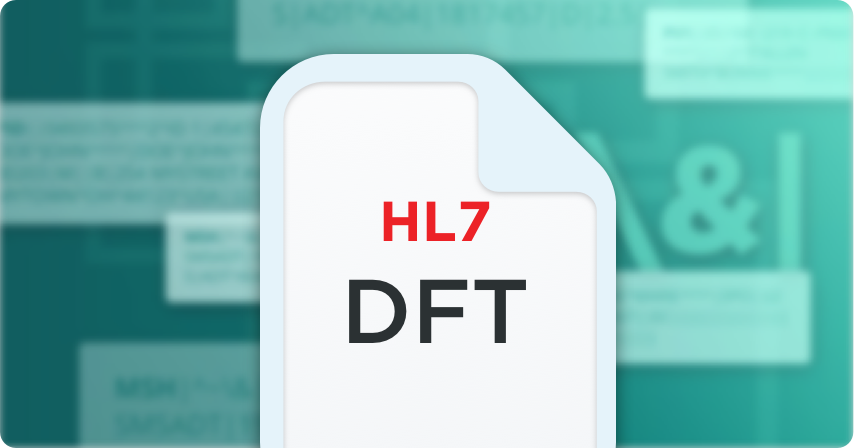
HL7 DFT
Detailed Financial Transactions
The HL7 Detailed Financial Transaction (DFT) message is used to transmit financial information between various systems and to a billing system for patient accounting purposes and claims generation.
DFT (Detailed Financial Transaction)
DFT messages contain information on billing accounts, charges, payments, adjustments, insurance, and other related patient billing and accounts receivable information.
A typical HL7 DFT message transmission is between the Department System Scheduler (DSS)/Order Filler (ie. the service provider) and the Charge Processor (ie. Insurer or payee). When a patient receives a service, the DSS/Order Filler verifies that the service has been completed and the Charge Processor receives the required patient demographics and account information for patient registration.

Sample DFT Message
Shown below is an example of an HL7 version 2.5 DFT^P03, Post Detail Financial Transactions message:
EVN||20150420134725||
PID|1|12345|12345^^^MIE&1.2.840.114398.1.100&ISO^MR||MOUSE^MICKEY^S||19281118|M|||123 Main St.^^Lake Buena Vista^FL^3283|||||||||||||||||||
FT1|1|1133||20150325000000||CG|99244|Consultation-Level 4||1|0.000000|||||^^^^OFFICE^^^^Office||BILLING|B69^Cysticercosis^I10~B60.0^Babesiosis^I10|123^Physician^Dr|||1133|1^Adams^Douglas|99244|
PR1|1|CPT|99244|Consultation-Level 4|20150325000000|||||||123^Physician^Dr|B69^Cysticercosis^I10~B60.0^Babesiosis^I10|
DG1|1|ICD10|B69^Cysticercosis^I10|Cysticercosis|20150325000000|F|||||||||0|123^Physician^Dr
DG1|2|ICD10|B60.0^Babesiosis^I10|Babesiosis|20150325000000|F|||||||||0|123^Physician^Dr
| Segment | Description |
|---|---|
| MSH | Message Header. The header contains information about the sending system and location, the receiving system and location, the date and time of when the message was created, the type of trigger event being communicated, and the HL7 message version being used. This segment is required. |
| EVN | Event Type. Communicates the event that occurred in order for the message to be generated. This is a crucial part of the data flow, as it indicates where and when a message is sent based on the type of event. This segment is required. |
| PID | Patient Identification. Important patient identification information, including patient demographics. This segment is required. |
| {FT1} | Financial Transaction. The necessary information to post charges, payments, adjustment, etc. to patient accounting records. This segment is required. |
| {PR1} | Procedures. Holds information about the various procedures performed for a patient. This is used for medical record encoding and billing systems. This segment can be repeated to communicate information about multiple procedures. |
| [{DG1}] | Diagnosis Information. Contains information about a patient’s diagnosis and uses ICD coding standards to communicate specific diseases, signs, symptoms, abnormalities, patient complaints, etc. This segment is optional and can be repeating. |
| [ ] = optional, { } = repeating | |
For more information on implementing various HL7 message types, please refer to the HL7 Messaging Standard Implementation Guides corresponding to your required version.
Working With DFT Messages
Are you working with HL7 DFT messages? In order to successfully process these messages, it's important to understand the specific format that the sending and receiving facilities are expecting the DFT messages to adhere to. Discrepancies can occur due to the version of HL7, system input error, or even simply human error when the messages were created.
How does Iguana ensure that DFT messages are properly formatted to ensure system compatibility?
Iguana is a data integration platform that allows you to easily customize the format, structure, and field values of your HL7 messages so that they are normalized, ensuring compatibility with any system you might need to interact with.
Other HL7 Message Types
- HL7 ADT (Admit, Discharge and Transfer)
- HL7 ORM (Order Entry)
- HL7 ORU (Observation Result)
- HL7 MDM (Medical Document Management)
- HL7 DFT (Detailed Financial Transactions)
- HL7 BAR (Billing Account Record)
- HL7 SIU (Scheduling Information Unsolicited)
- HL7 RDS (Pharmacy/treatment Dispense)
- HL7 RDE (Pharmacy/Treatment Encoded Order)
- HL7 ACK (Acknowledgement Message)